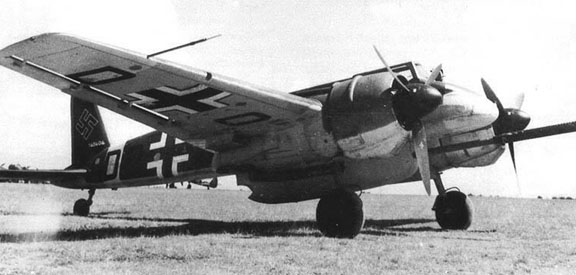
The F6F design began as a development of the F4F powered by the R-2600 engine, but soon evolved into a much larger and more capable aircraft, with the R-2800 engine. The F6F was designed and put into service in a very short period, assuring the ascendance of the USN over the A6M 'Zero' from the second half of 1943 onwards. It was credited with 76% of all aircraft destroyed by USN carrier fighters. In line with Grumman tradition, the F6F was a rugged aircraft that lacked easthetic appeal. Typical features were a tail-down attitude in level flight, because of the engine trust line, and the biggest wings fitted to a WWII fighter.
Wing span: 13.06 m
Lenght: 10.24 m
Height: 3.99 m
Weight (max): 6,443 kg
Propulsion: 1x Pratt & Whitney R-2800-10W
Speed (max): 611 km/h
Service ceiling: 11,400 m
Armament: 2x 20 mm cannons, 4x 12.7mm MG, 6x rockets, 2x bombs
Bomb load: 900 kg
Crew: 1
British Westland Whirlwind Mk.Ia

The Whirlwind was developed to fullfill a requirement (F.37/35) for a long range escort fighter. The type was a stable and pleasant aircraft to fly and had a formidable amount of firepower for the time. Unfortunately development was delayed by the unreliable Peregrine engine. Also the type suffered from an unusually high landing speed (80 mph) which meant that the type couldn't operate from short, grass fields. These issues led the type to see only limited production. Eventually two squadrons, nos 263 and 137, were equipped with the type and in August 1941 escorted Blenheims on an attack against Cologne in daylight. After the RAF switched to night bombing the type was relegated to cross-channel straffing and bombing sorties.
Wing span: 13.72 m
Lenght: 9.83 m
Height: 3.52 m
Weight (max): 5166 kg
Propulsion: 2x Rolls-Royce Peregrine I
Speed (max): 580 km/h
Service ceiling: 9144 m
Armament: 4x 20mm Hispano Suiza HS-404 Cannons, 1x bomb
Bomb load: 454 kg
Crew: 1
Russian Ilyushin Il-10

Succesor of the Il-2, it took over all the essential components of it but with a more aerodynamic shape and a more powerful armament and armor. That careful finishing up paid up since the Il-10 was faster than its model despite being heavier and that contributed much to a lessened vulnerability. Entered in service during the offensive on the Oder in Febrauary of 1945, it had not time enough to supersede its predecessor before the end of the conflict. It continued its career afterwards and was delivered in quantity to most of the allies of the USSR and built under licence in Czechoslovakia.
Wing span: 13.40 m
Lenght: 11.65 m
Height: 4.18 m
Weight (max): 6535 kg
Propulsion: 1x Mikulin AM-42
Speed (max): 530 kph
Service ceiling: 7250m
Armament: 2x 7.62mm ShKAS, 2x 23mm VYa-23, 1x 20mm UB-20, 4x rockets
Bomb load: 1000 kg
Crew: 2
German Henschel Hs-129B-2

The Hs 129 was certainly well armored, with the pilot sitting in essentially an armor-plated tub - completely surrounded by 6-12mm steel plating. Initial flight tests of the first prototype were conducted in January 1939, but the pilot's armor tub was at a fair cost to the performance - initally with 650hp Argus As-410 radials, the aircraft was slow and sluggish. Henschel proposed to redesign completely with Daimler DB-601 engines, which had proved excellent in the Messerschmitt Bf-109, but the urgency of the requirement and shortage of the DB-601's forced Henschel to switch to 700hp Gnome-Rhône engines, recently acquired from the occupation of France. The switch proved moderately successful, providing a fairly average ground attack aircraft. They first saw service on the Russian front early in 1942, and some in North Africa. However, the scorching sun and sand of the desert environments proved too much for the French radials, and attempts at sand filters were also unsucessful. All the African machines were either captured by Allied forces, or moved to the Russain arena.
Wing span: 14.2 m
Lenght: 9.75 m
Height: 3.25 m
Weight (max): 5110 kg
Propulsion: 2x Gnome-Rhône 14M 04/05
Speed (max): 408 km/h
Service ceiling: 9000 m
Armament: 2x 13mm MG 131, 2x 20mm MG 151/20, 1x 75mm BK 7.5.
Bomb load: 350 kg
Crew: 1




 This topic is locked
This topic is locked










